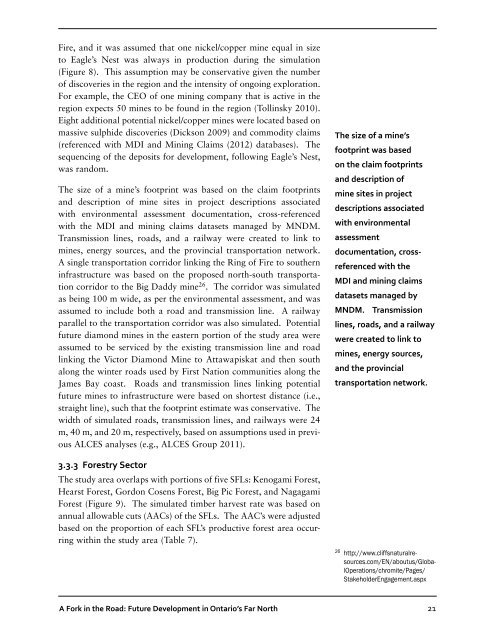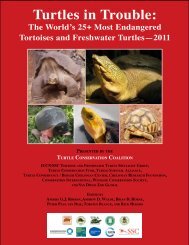Create successful ePaper yourself
Turn your PDF publications into a flip-book with our unique Google optimized e-Paper software.
Fire, and it was assumed that one nickel/copper mine equal in size<br />
to Eagle’s Nest was always in production during the simulation<br />
(Figure 8). This assumption may be conservative given the number<br />
of discoveries in the region and the intensity of ongoing exploration.<br />
For example, the CEO of one mining company that is active in the<br />
region expects 50 mines to be found in the region (Tollinsky 2010).<br />
Eight additional potential nickel/copper mines were located based on<br />
massive sulphide discoveries (Dickson 2009) and commodity claims<br />
(referenced with MDI and Mining Claims (2012) databases). The<br />
sequencing of the deposits for development, following Eagle’s Nest,<br />
was random.<br />
The size of a mine’s footprint was based on the claim footprints<br />
and description of mine sites in project descriptions associated<br />
with environmental assessment documentation, cross-referenced<br />
with the MDI and mining claims datasets managed by MNDM.<br />
Transmission lines, roads, and a railway were created to link to<br />
mines, energy sources, and the provincial transportation network.<br />
A single transportation corridor linking the Ring of Fire to southern<br />
infrastructure was based on the proposed north-south transportation<br />
corridor to the Big Daddy mine 26 . The corridor was simulated<br />
as being 100 m wide, as per the environmental assessment, and was<br />
assumed to include both a road and transmission line. A railway<br />
parallel to the transportation corridor was also simulated. Potential<br />
future diamond mines in the eastern portion of the study area were<br />
assumed to be serviced by the existing transmission line and road<br />
linking the Victor Diamond Mine to Attawapiskat and then south<br />
along the winter roads used by First Nation communities along the<br />
James Bay coast. Roads and transmission lines linking potential<br />
future mines to infrastructure were based on shortest distance (i.e.,<br />
straight line), such that the footprint estimate was conservative. The<br />
width of simulated roads, transmission lines, and railways were 24<br />
m, 40 m, and 20 m, respectively, based on assumptions used in previous<br />
ALCES analyses (e.g., ALCES Group 2011).<br />
3.3.3 Forestry Sector<br />
The study area overlaps with portions of five SFLs: Kenogami Forest,<br />
Hearst Forest, Gordon Cosens Forest, Big Pic Forest, and Nagagami<br />
Forest (Figure 9). The simulated timber harvest rate was based on<br />
annual allowable cuts (AACs) of the SFLs. The AAC’s were adjusted<br />
based on the proportion of each SFL’s productive forest area occurring<br />
within the study area (Table 7).<br />
The size of a mine’s<br />
footprint was based<br />
on the claim footprints<br />
and description of<br />
mine sites in project<br />
descriptions associated<br />
with environmental<br />
assessment<br />
documentation, crossreferenced<br />
with the<br />
MDI and mining claims<br />
datasets managed by<br />
MNDM. Transmission<br />
lines, roads, and a railway<br />
were created to link to<br />
mines, energy sources,<br />
and the provincial<br />
transportation network.<br />
26<br />
http://www.cliffsnaturalresources.com/EN/aboutus/GlobalOperations/chromite/Pages/<br />
StakeholderEngagement.aspx<br />
A Fork in the Road: Future Development in Ontario’s Far North<br />
21







![RaLand / SeaScape [PDF] - Wildlife Conservation Society](https://img.yumpu.com/49974326/1/190x245/raland-seascape-pdf-wildlife-conservation-society.jpg?quality=85)









